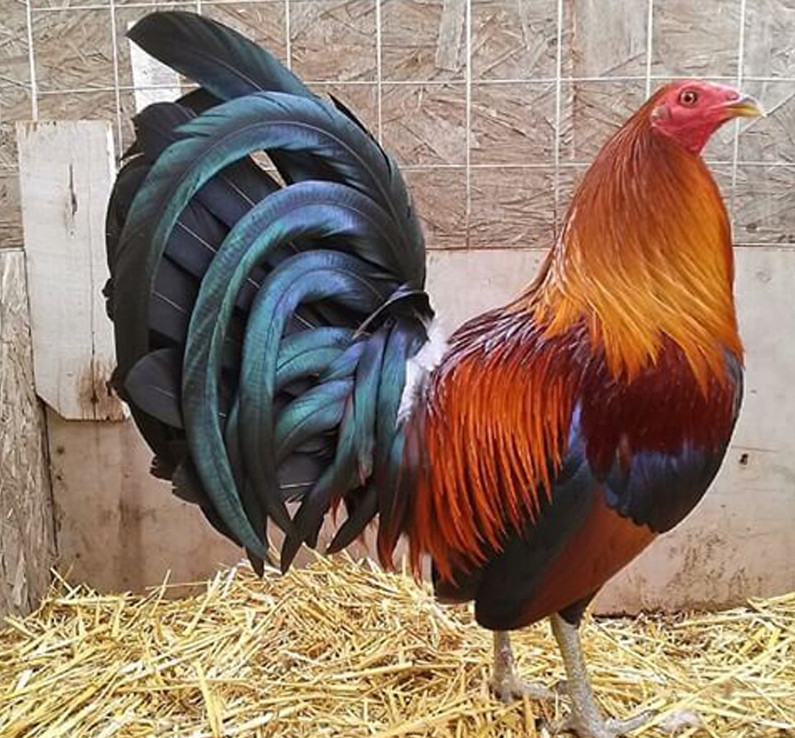McLean Hatch is one of the most popular gamecocks not because of its winning record but because of its “do or die, no retreat-no surrender” behaviors. In short, of all the gamefowl breeds and roosters, Mclean Hatches have the bigger balls and are willing to die rather than run away.
McLean Hatch Origin and Profile
The Hatch blood came from Sanford Hatch who blended, as the story goes, a Kearney Whitehackle with a Kearney Brown Red, mixing in other blood like the Herman Duryea Boston Roundheads, and Jim Thompson Mahoganies, among others, to come up with his signature Hatch fowl.
From the Sandy Hatch stocks came Ted McLean’s version of Hatch that came both yellow and green-legged. Supposedly, these were the better Hatches that gave rise to the other variants of the McLean, like Gilmore Hatch, Blueface Hatch, Jack Walton Hatch, Kentucky Hatch, Oakgrove Hatch, etc.

The McLean Hatch is one of the legendary gamefowl breeds that has stood the test of time among broodstock breeders. Its offshoot, the Blueface Hatch, has gained its following among gamefowl aficionados looking for a good fighter. Ted McLean retired from the Gamefowl competition in December 1954.
In the early thirties, Mr. E.S. Hatch and Mr. E.T. McLean were on the stock exchange floor as colleagues and were sharing some gamefowl for crossing to find that perfect fighter. At the time, the Hatch stock consisted of four primary bloodlines. These were the Kearney makeup of the two strains Mike Kearney brought from Ireland, namely
- the “beasty” Breasted Light Reds (Whitehackles) and
- the Brown Breasted Reds, plus
- He added the Herman Duryea fowl (commonly called Boston Roundheads) when he worked for Mr. Duryea.
With these three bloodlines, Mr. Hatch crossed into a fourth, the green-leg Thompson (Jim Thompson) fowl. The created progeny of the Mclean Hatch, Ted himself considered as ‘straight stuff’ gamefowl or cocks with gameness, toughness, and power—the mark of the Hatch bloodline.
The McLean Hatch Fighting Style
While the first McLean Hatches did not win all the time, they were admired by many for their aggressive, no-holds-barred attitude and suicide attack mode.
The previous bloodlines of Hatches did not win all the time, and they were admired by many for their aggressive, no-holds-barred attitude and suicide attack mode.
McLean were rather poor cutters, low-headed dumb fighters that usually fly into two or three hits before throwing one of their patented haymakers at their opponents. They either won spectacularly or lost as incredibly as well.
When modern gamefowl became faster, a pure Mclean Hatch became less of a threat, and they are now considered at a disadvantage if fought pure. Their value today is as base stock or to produce battle cocks infused with the ‘straight stuff’ Hatch traits: gameness, power hitting, and toughness.
Modern hatches are faster and more high-flying, and many are becoming more brainy than usual. Their usual characteristics like power and gameness are still there, their blows often packing a wallop. They are medium-stationed and pea-combed, with some coming straight-combed.
Frequently Asked Questions About McLean Hatch Gamefowl
McLean Hatch Gamefowl is a popular breed known for its striking appearance, competitive nature, and excellent fighting abilities. Here are some frequently asked questions about McLean Hatch Gamefowl:
-
What is McLean Hatch Gamefowl?
McLean Gamefowl is a breed of gamefowl (roosters and hens) known for their distinctive red plumage, intelligent and fierce disposition, and strong fighting abilities. They are often used in cockfighting competitions.
-
Who developed the McLean Hatch Gamefowl breed?
Herman Pinnon developed the McLean Gamefowl breed in the United States. He crossed the Albany and Roundhead bloodlines to create this breed, which exhibits traits like agility, speed, and gameness.
-
What does McLean Hatch Gamefowl look like?
McLean Gamefowl have bright red plumage, yellow legs, and a robust and compact body. They are typically medium-sized with well-developed muscles, giving them a muscular and imposing appearance. Their combs and wattles are generally small to avoid easy targets in a cockfight.
-
Are McLean Hatch Gamefowl suitable for cockfighting?
Yes, McLean Gamefowl are considered excellent fighters and are often used in cockfighting competitions. They are known for their aggression, courage, and fighting spirit, making them highly sought after in the sport.
-
What are some common traits of McLean Hatch Gamefowl?
Some common traits of McLean Gamefowl include high energy levels, great endurance, and excellent cutting and striking abilities. They are known for their intelligence and can quickly adapt to various fighting styles.
-
How do you care for McLean Hatch Gamefowl?
Caring for McLean Hatch Gamefowl involves providing proper nutrition, clean water, shelter, and protection from harsh weather conditions. Regular exercise and conditioning are also essential to maintain their physical fitness. Additionally, you should ensure they receive appropriate veterinary care and regular check-ups.
-
Do poultry associations recognize McLean Hatch Gamefowl?
Gamefowl breeds, including McLean, are typically not recognized by standard poultry associations since they are primarily bred for cockfighting rather than exhibition or utility purposes.
8. Can McLean Hatch Gamefowl be used for other purposes?
While McLean Gamefowl are primarily bred for cockfighting, some may keep them for ornamental or breeding purposes. They can also be used for meat and egg production, although their fighting qualities make them less suitable than traditional utility breeds.
9. Where can I purchase McLean Hatch Gamefowl?
You can find McLean Gamefowl through breeders and sellers who specialize in gamefowl. Be sure to research reputable sources and ensure that any transactions are conducted in compliance with local laws and regulations.
It’s essential to note that the legality and ethics of cockfighting are highly debated and controversial. Always consider the animals’ welfare and abide by local laws and regulations.
See Also:
- Kelso Gamefowl and its Fighting Style
- 10 Best Fighting Rooster and Gamefowl Breeds
- Sweater Gamefowl History and Its Fighting Style
- Top 7 Best Gamefowl Breeds
- Lists of Gamefarms and Gamefowl Breeders in Bacolod and Negros Island
